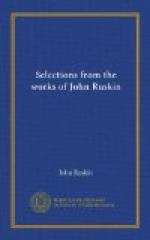“What I have had under consideration is the sublimest style, particularly that of Michael Angelo, the Homer of painting. Other kinds may admit of this naturalness, which of the lowest kind is the chief merit; but in painting, as in poetry, the highest style has the least of common nature.”
From this passage we gather three important indications of the supposed nature of the Great Style. That it is the work of men in a state of enthusiasm. That it is like the writing of Homer; and that it has as little as possible of “common nature” in it.
First, it is produced by men in a state of enthusiasm. That is, by men who feel strongly and nobly; for we do not call a strong feeling of envy, jealousy, or ambition, enthusiasm. That is, therefore, by men who feel poetically. This much we may admit, I think, with perfect safety. Great art is produced by men who feel acutely and nobly; and it is in some sort an expression of this personal feeling. We can easily conceive that there may be a sufficiently marked distinction between such art, and that which is produced by men who do not feel at all, but who reproduce, though ever so accurately, yet coldly, like human mirrors, the scenes which pass before their eyes.
Secondly, Great Art is like the writing of Homer, and this chiefly because it has little of “common nature” in it. We are not clearly informed what is meant by common nature in this passage. Homer seems to describe a great deal of what is common:—cookery, for instance, very carefully in all its processes.[42] I suppose the passage in the Iliad which, on the whole, has excited most admiration, is that which describes a wife’s sorrow at parting from her husband, and a child’s fright at its father’s helmet;[43] and I hope, at least, the former feeling may be considered “common nature.” But the true greatness of Homer’s style is, doubtless, held by our author to consist in his imaginations of things not only uncommon but impossible (such as spirits in brazen armour, or monsters with heads of men and bodies of beasts), and in his occasional delineations of the human character and form in their utmost, or heroic, strength and beauty. We gather then on the whole, that a painter in the Great Style must be enthusiastic, or full of emotion, and must paint the human form in its utmost strength and beauty, and perhaps certain impossible forms besides, liable by persons not in an equally enthusiastic state of mind to be looked upon as in some degree absurd. This I presume to be Reynolds’s meaning, and to be all that he intends us to gather from his comparison of the Great Style with the writings of Homer. But if that comparison be a just one in all respects, surely two other corollaries ought to be drawn from it, namely,—first, that these Heroic or Impossible images are to be mingled with others very unheroic and very possible; and, secondly, that in the representation of the Heroic or Impossible forms, the greatest care must be taken in finishing the details, so that a painter must not be satisfied with painting well the countenance and the body of his hero, but ought to spend the greatest part of his time (as Homer the greatest number of verses) in elaborating the sculptured pattern on his shield.




